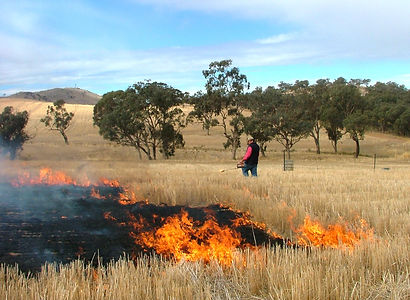2004 - 2009/2013
Alternative Strategies for Managing Cereal Stubble
HMLG led a ground-breaking study to investigate alternative strategies for managing cereal stubble that would reduce the need for burning by increasing the rate of stubble breakdown over the fallow period
Cereal stubble has conventionally been removed by burning resulting in an increase in net carbon emissions, as well as increased soil erosion and soil moisture loss
HMLG carried out this series of studies between 2004 and 2009, with a follow up project conducted in 2013. We investigated the effects of mechanical, chemical and biological treatments on stubble breakdown and soil condition. These are summarised by year below.
Our findings have formed the basis for much larger and longer-term studies now led by CSIRO, Grains Research and Development Corporation, and Charles Sturt University


2005- 2006
Soil impacts of different cereal stubble breakdown methods
In 2006, a large plot experiment with two replications was established at Bobbara Station, Galong, to investigate:
-
options for cheap and efficient stubble management; and
-
the impact of various stubble management techniques on soil moisture, soil structure, ground cover and livestock condition
Due to the dry seasonal conditions, the rate of stubble decomposition was low. No statistically significant differences between the various treatments was found for either the resultant stubble loads or the amount of soil moisture in the top 5 cm of the soil.
This trial highlighted the variability that can occur with stubble loads across a paddock, and the implications this can have on assessing the effectiveness of various treatments. Due to this variability it was decided that continuing the trial in its existing format would be difficult. It was therefore decided in future seasons to undertake a number of case studies looking at current best management practice of cereal stubble across the Jugiong Creek Catchment.

2004 - 2005
Mechanical vs biological methods of cereal stubble breakdown
During the first year of the study, two non-replicated on farm demonstrations (Wallendbeen and Jugiong) were established to investigate the effects of two mechanical and four biological (chemical) treatments on stubble breakdown over the summer/autumn period.
Mechanical treatments which laid the stubble flat on the soil surface was generally found to improve the extent of breakdown. Given the dry conditions over the project period, no other major differences observed.
A survey of 42 growers indicated that most growers (86%) retained stubble for a period of time, but many growers still burned it prior to sowing the next seasons crop.

2006 - 2009
Soil impacts of different cereal stubble breakdown methods at five case study sites
From 2006 to 2009, the stubble management project was carried out as a number of case studies looking at current best management practice of cereal stubble across the Jugiong Creek Catchment. The focus was on methods that increased the contact between stubble and soil surface.
Results varied from year to year, with drought conditions often resulting in much lower stubble loads than normal. For instance, in 2006 an average of 1-2 tonnes/ha of stubble was recorded compared to a potential 5 - 6 tonnes/ha. Further details may be found in the project reports linked below.

2013
Evaluating the effect of wheat stubble management on nutrient release
As a result of HMLG’s Cereal Stubble Management Project, many growers adopted a machine called the Speed-Tiller to chop stubble back into the soil. This approach increases soil contact for pre-emergent herbicides and potentially encourages faster breakdown of stubble due to better contact between the soil and stubble.
The aims of this project were to determine if different management techniques, including use of the Speed-Tiller, influenced nutrient release from wheat stubble and also, if the timing of treatments (early in summer and just prior to sowing) had any impact. Ten different treatments were evaluated using a replicated (three replicates) randomly designed plot trial.
Stubble management treatments had an influence on the decomposition of some nutrients, in particular Nitrogen, Phosphorus, Sulphur, Zinc and Calcium
Results indicated that the effect of burning on nutrient release was minimal, while the Speed-Tiller treatments had a positive effect on the decomposition of stubble and nutrient release. However, it was unclear from this trial, if any one treatment produced a higher level of nutrient release over another.
